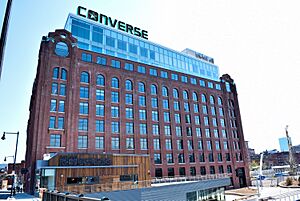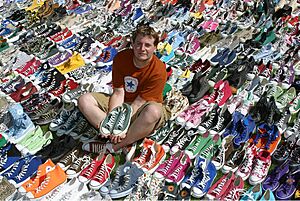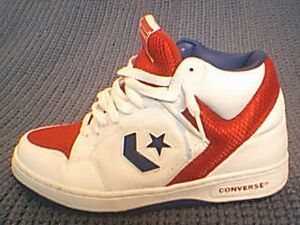Converse (brand) facts for kids
 |
|

World headquarters building on Boston's Lovejoy Wharf
|
|
| Subsidiary | |
| Industry | |
| Founded | February 1908 in Malden, Massachusetts, U.S. |
| Founder | Marquis Mills Converse |
| Headquarters | Boston, Massachusetts, U.S. |
|
Number of locations
|
136 (2023) |
|
Area served
|
Worldwide |
|
Key people
|
Aaron Cain (president and CEO) |
| Products | |
| Brands |
|
| Revenue | |
| Parent |
|
Converse is a famous American brand. It sells and makes footwear (shoes), clothing, and accessories. Marquis Mills Converse started the company in 1908 in Malden, Massachusetts. It was first called the Converse Rubber Shoe Company. Over the years, other companies bought Converse. Since 2003, it has been part of Nike, Inc..
Converse first made rubber-soled shoes and boots for winter. During World War II, they made shoes for the military. Converse was once a top maker of athletic shoes in the U.S. But in the 1970s, other brands became more popular. Today, Converse sells products like Chuck Taylor All-Stars, Cons, Jack Purcell, and One Star shoes. They often work with other brands to make special shoes. In 2023, Converse earned $2.4 billion, showing how popular their casual fashion items are.
Contents
History of Converse
How Converse Started (1908–1940)
Marquis Mills Converse was 47 years old when he started his company. It was February 1908, in Malden, Massachusetts. His company, the Converse Rubber Shoe Company, made rubber shoes. They sold winter boots, galoshes, tennis shoes, and even car tires.
In 1916, Converse began making basketball shoes. By 1917, they launched the Converse All-Star basketball shoe. This shoe became very popular during World War I and the Spanish flu pandemic.
In 1922, a basketball player named Charles H. "Chuck" Taylor visited Converse. He complained about his feet hurting. Converse hired him as a salesperson and brand ambassador. He traveled across the U.S., promoting the shoes. In 1932, Chuck Taylor's signature was added to the All-Star patch. This patch was on the side of the high-top sneakers. He worked for Converse until he passed away in 1969. Sales for the All-Star shoes grew a lot. But in 1929, the company went bankrupt. In 1939, the Stone Family bought Converse. They owned it until 1972.
War, Growth, and Challenges (1941–2001)
When the U.S. joined World War II in 1941, Converse changed its production. They started making rubber shoes, coats, and protective suits for the military. After the war, they went back to making sports shoes. They mainly made high-top shoes in black or white.
In the 1950s and 1960s, Converse promoted an American image. They published the Converse Basketball Yearbook. An artist named Charles Kerins drew covers for it. These covers showed Converse's role in the lives of high school and college athletes. In 1957, Converse released a low-cut All-Star shoe. By 1966, you could buy the shoes in many school colors.
Converse also made special shoes for the New York Renaissance. This was the first all-African-American professional basketball team. The shoes were designed to be "non-skid" for better grip. An extra rubber strip was added to protect the shoes during quick turns. This was called the "pivot button." In 1962, Wilt Chamberlain scored 100 points in an National Basketball Association (NBA) game. He wore All-Stars during this famous game.
By the early 1970s, Converse made many different products. These included sports goods and industrial items. The Eltra Corporation bought Converse in 1972. Converse also bought PF Flyers, a competitor, from B.F. Goodrich. However, courts said this was a monopoly. So, the deal was broken up. Converse only kept the rights to the Jack Purcell shoe line. The chevron-and-star logo was created by an employee named Jim Labadini. This logo is still on many Converse shoes today.
Allied Corporation bought Eltra in 1979. Allied then sold its consumer product businesses in the 1980s. In 1986, Interco Incorporated bought Converse. They then sold it off as a separate company in 1994.
Converse lost its top spot in athletic shoes from the 1970s onwards. New companies like Puma, Adidas, and Nike became very popular. Later, Reebok introduced new shoe designs and technology. Converse was no longer the official shoe of the NBA. In the 1980s, canvas-rubber shoes became popular again for casual wear. But Converse relied too much on its "All Stars" basketball brand. The market for these shoes dropped by 1989–1990. By 2000, Converse was struggling with a lot of debt.
Converse filed for bankruptcy on January 22, 2001. On March 30, their last factories in the U.S. closed. All production moved overseas. In April 2001, a group called Footwear Acquisitions bought the brand. They worked to turn the company around. During this time, Converse moved its main office from North Reading, Massachusetts, to North Andover, Massachusetts. The company stayed in North Andover for 13 years.
Joining Nike and New Headquarters (2002–Present)
In July 2003, Nike bought Converse for $309 million. In January 2013, Converse announced plans for a new main office building. It was built near North Station in downtown Boston. This new building is on the Lovejoy Wharf. It was part of a big project to fix up the area and open up the waterfront. The 10-story office building is 214,000 square feet. It has a music recording studio, a 5,000 square foot gym, a yoga studio, and a 3,500 square foot store.
In May 2023, Converse hired Jared Carver as its new president and CEO. In August 2025, Carver stepped down from his role. Aaron Cain replaced him. Cain was previously a vice president at Nike.
Converse Products
Chuck Taylor All-Stars
Converse started making an early basketball shoe in 1917. They redesigned it in 1922. This was after Chuck Taylor asked for a better shoe. He wanted more support and flexibility. After Converse added Taylor's signature to the ankle patch, they became known as Chuck Taylor All Stars. By the 1960s, Converse had about 70 to 80 percent of the basketball shoe market. But the shoe became less popular in the 1970s. This was because basketball players started wearing shoes from other brands. However, Chuck Taylor All-Stars became popular again in the 1980s. People liked them as cool, casual shoes.
Chuck Taylor All-Stars have appeared in over 650 movies. Some of these include Back to the Future, I, Robot, Grease, and Stand by Me. David Tennant, who played the Tenth Doctor on Doctor Who, wore red and cream high-top Converse shoes.
The Weapon
In 1986, Converse released "The Weapon" basketball shoe. It came in two color schemes to match basketball team uniforms. You could buy it as a high-top or a low-cut shoe. It was made of leather, with thick padding inside the heel for comfort. Famous basketball players Larry Bird and Magic Johnson were the first to promote "The Weapon." They were in a Converse TV ad in 1985. Axl Rose also wore them in the Guns N' Roses music video "Estranged."
Converse has re-released "The Weapon" several times. This includes "The Loaded Weapon" in 2003 and "The Weapon 86" in 2008. Before "The Weapon," Converse launched the "One Star" in 1974. They also released the "Pro Leather" in 1976 and the "Starion" in 1984. All these shoes were known for basketball.
Chuck Taylor II
A new version of the Chuck Taylor All-Star, called the "Chuck Taylor II," came out on July 28, 2015. It uses Nike technology. It looks mostly like the original shoe on the outside. But it uses newer materials for the inside sole.

Converse Sponsorships
In 2019, Converse started making performance basketball shoes again. They launched the All-Star Pro BB. Kelly Oubre Jr. was the first player to try this new shoe. It mixed the classic Converse look with modern Nike technology. After that, Converse signed other NBA and WNBA players. These included Draymond Green in March 2020 and Natasha Cloud (the first WNBA player) in June. They also signed Shai Gilgeous-Alexander in July. Other players like Rudy Gay, P. J. Tucker, and Jordan Clarkson also joined. Some of these players also wear other brands.
Shai Gilgeous-Alexander, a point guard for the Oklahoma City Thunder, is now a main face for the brand. His shoe, "Chase the Drip," was released on September 13, 2022.
Basketball Teams (Former)
- Marquette Golden Eagles – switched to Jordan Brand
- Western Kentucky Hilltoppers – shoes only
 Auxilium Pallacanestro Torino (1984–1988)
Auxilium Pallacanestro Torino (1984–1988)
Soccer Club Teams
 Liverpool (From 2023–2024 season)
Liverpool (From 2023–2024 season)
Soccer Teams (Former)
 Atlético Nacional (2001–2002)
Atlético Nacional (2001–2002) Politehnica Timișoara (2006–2008)
Politehnica Timișoara (2006–2008)
Converse and Skateboarding
In the 1980s, Converse supported several important skateboarders. These included Jason Jessee, Rodney Mullen, and Mark Rogowski. In 2009, Converse started its skateboarding program under the "Cons" name. They had a team of "ambassadors" like Kenny Anderson and Rune Glifberg. In 2012, Jason Jessee and Mike Anderson joined the team.
In August 2012, Converse sponsored a skate event in Huntington Beach, California. Many skaters took part in the competition. Ben Raybourn won the top prize of $20,000. Aaron Homoki won $3,000 for the Best Trick.
As of July 2014, the Cons skateboard team included many talented skaters. Zered Bassett filmed a new ad in July 2014. In it, he skateboarded through New York City wearing a new skate version of the Converse Weapon shoe.
In February 2024, Converse and Phaidon released a book called Skateboard. The book tells the history of skateboarding from the 1950s until today. Jonathan Olivares, a designer and skater, put the book together.
Converse and Helping Others
Converse created a special collection called "1Hund (RED)." Fifteen percent of the money from these sales helps prevent HIV/AIDS. One hundred artists from around the world designed items for this collection. This was part of the (RED) campaign. Skateboarder Anthony Pappalardo released a (RED) version of his popular skate shoe in February 2010. He explained that by doing what he loved, he could also help people.
In 2012, Converse was listed as a partner in the (RED) campaign. Other brands like Nike, Inc. also joined. The campaign's goal was to stop the HIV virus from passing from mothers to their children by 2015. Their slogan was "Fighting For An AIDS Free Generation."
In the winter of 2018, Converse worked with important people in Los Angeles. They created a collection to honor those who help move the culture forward in the city. Some of these people included Vince Staples and Dr. Woo.



